Developer Guide
- Acknowledgements
- Setting up, getting started
- Design
- Implementation
- Documentation, logging, testing, configuration, dev-ops
-
Appendix: Requirements
- Product scope
- User stories
-
Use cases
- Use case: Login
- Use case: Create password
- Use case: Add a person
- Use case: Delete a single person by Index
- Use case: Delete multiple persons by multiple indexes
- Use case: Delete single person by name
- Use case: Filter contacts
- Use case: Export contacts
- Use case: Load contacts
- Use case: View a person’s contact details
- Use case: Edit a contact by index
- Use case: Edit a contact by name
- Use case: Switch to light or dark mode
- Use case: Undo commands
- Non-Functional Requirements
- Glossary
- Person: Referring to TA or Professor
- Appendix: Instructions for manual testing
- Appendix: Planned Enhancements
- Appendix: Known Limitations
Acknowledgements
- {list here sources of all reused/adapted ideas, code, documentation, and third-party libraries – include links to the original source as well}
Setting up, getting started
Refer to the guide Setting up and getting started.
Design
.puml files used to create diagrams in this document can be found in the diagrams folder. Refer to the PlantUML Tutorial at se-edu/guides to learn how to create and edit diagrams.
Architecture

The Architecture Diagram given above explains the high-level design of the App.
Given below is a quick overview of main components and how they interact with each other.
Main components of the architecture
Main has two classes called Main and MainApp. It is responsible for,
- At app launch: Initializes the components in the correct sequence, and connects them up with each other.
- At shut down: Shuts down the components and invokes cleanup methods where necessary.
Commons represents a collection of classes used by multiple other components.
The rest of the App consists of four components.
-
UI: The UI of the App. -
Logic: The command executor. -
Model: Holds the data of the App in memory. -
Storage: Reads data from, and writes data to, the hard disk.
How the architecture components interact with each other
The Sequence Diagram below shows how the components interact with each other for the scenario where the user issues the command delete 1.

Each of the four main components (also shown in the diagram above),
- defines its API in an
interfacewith the same name as the Component. - implements its functionality using a concrete
{Component Name}Managerclass (which follows the corresponding APIinterfacementioned in the previous point.
For example, the Logic component defines its API in the Logic.java interface and implements its functionality using the LogicManager.java class which follows the Logic interface. Other components interact with a given component through its interface rather than the concrete class (reason: to prevent outside component’s being coupled to the implementation of a component), as illustrated in the (partial) class diagram below.

The sections below give more details of each component.
UI component
The API of this component is specified in Ui.java

The UI consists of a MainWindow that is made up of parts e.g.CommandBox, ResultDisplay, PersonListPanel, StatusBarFooter etc.
The UI also consists of a LoginWindow that is made up of parts e.g. WelcomeSection,LoadingSection,CreatePasswordSection etc.
The UI component uses the JavaFx UI framework. The layout of these UI parts are defined in matching .fxml files that are in the src/main/resources/view folder. For example, the layout of the MainWindow is specified in MainWindow.fxml
All these, including the MainWindow and LoginWindow, inherit from the abstract UiPart class which captures the commonalities between classes that represent parts of the visible GUI.
The UI component,
- executes user commands using the
Logiccomponent. - listens for changes to
Modeldata so that the UI can be updated with the modified data. - keeps a reference to the
Logiccomponent, because theUIrelies on theLogicto execute commands. - depends on some classes in the
Modelcomponent, as it displaysPersonobject residing in theModel.
Logic component
API : Logic.java
Here’s a (partial) class diagram of the Logic component:

How the Logic component works:
- When
Logicis called upon to execute a command, it uses theAddressBookParserclass to parse the user command. - This results in a
Commandobject (more precisely, an object of one of its subclasses e.g.,AddCommand) which is executed by theLogicManager. - The command can communicate with the
Modelwhen it is executed (e.g. to add a person). - The result of the command execution is encapsulated as a
CommandResultobject which is returned back fromLogic.
The Sequence Diagram below illustrates the interactions within the Logic component for the execute("delete 1") API call.
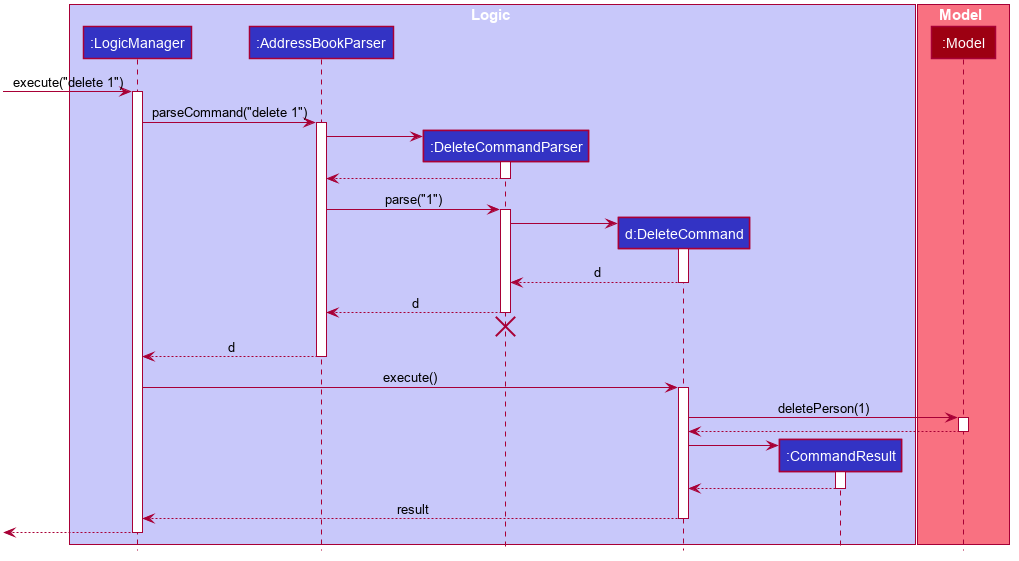
DeleteCommandParser should end at the destroy marker (X) but due to a limitation of PlantUML, the lifeline reaches the end of diagram.
Here are the other classes in Logic (omitted from the class diagram above) that are used for parsing a user command:

How the parsing works:
- When called upon to parse a user command, the
AddressBookParserclass creates anXYZCommandParser(XYZis a placeholder for the specific command name e.g.,AddCommandParser) which uses the other classes shown above to parse the user command and create aXYZCommandobject (e.g.,AddCommand) which theAddressBookParserreturns back as aCommandobject. - All
XYZCommandParserclasses (e.g.,AddCommandParser,DeleteCommandParser, …) inherit from theParserinterface so that they can be treated similarly where possible e.g, during testing.
Model component
API : Model.java

The Model component,
- stores the address book data i.e., all
Personobjects (which are contained in aUniquePersonListobject). - stores the currently ‘selected’
Personobjects (e.g., results of a search query) as a separate filtered list which is exposed to outsiders as an unmodifiableObservableList<Person>that can be ‘observed’ e.g. the UI can be bound to this list so that the UI automatically updates when the data in the list change. - stores a
UserPrefobject that represents the user’s preferences. This is exposed to the outside as aReadOnlyUserPrefobjects. - stores a
UserDataobject that represents the user’s personal data. This is exposed to the outside as aReadOnlyUserDataobjects. - stores a
UndoManagerobject that contains previous states of ModCheck. This is exposed to the outside through aUndoableinterface. - does not depend on any of the other three components (as the
Modelrepresents data entities of the domain, they should make sense on their own without depending on other components)
Tag list in the AddressBook, which Person references. This allows AddressBook to only require one Tag object per unique tag, instead of each Person needing their own Tag objects.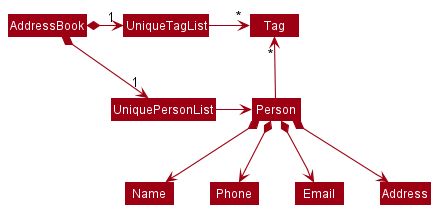
Storage component
API : Storage.java

The Storage component,
- can save both address book data and user preference data in json format, and read them back into corresponding objects.
- can also save the user’s personal data in json format, and read them back into corresponding objects
- inherits from
AddressBookStorage,UserPrefStorageandUserDataStorage, which means it can be treated as either one (if only the functionality of only one is needed). - depends on some classes in the
Modelcomponent (because theStoragecomponent’s job is to save/retrieve objects that belong to theModel)
Common classes
Classes used by multiple components are in the seedu.addressbook.commons package.
Implementation
This section describes some noteworthy details on how certain features are implemented.
Add Command
Purpose: Allow users to add contact details
Format: add n/NAME p/PHONE_NUMBER e/EMAIL d/DESCRIPTION [t/TAG]… [m/MODULE_TAG]…
Fields:
n/ : name of the person (COMPULSORY)
d/ : description of the person
e/ : email
p/ : phone number
t/ : tags
m/ : module tags
Constraints:
n/ : Alphanumeric characters and spaces, and it should not be blank
e/ : Emails should be of the format local-part@domain.
- The local-part should only contain alphanumeric characters and these special characters,
+_.- - The local-part may not start or end with any special characters.
This is followed by a
@and then a domain name. - The domain name is made up of domain labels separated by periods.
- The domain name must end with a domain label at least 2 characters long, have each domain label start and end with alphanumeric characters, have each domain label consist of alphanumeric characters, separated only by hyphens, if any.
p/ : Phone numbers should contain only numbers, and it should be at least 3 digits long.
t/ or m/ : Alphanumeric characters
![]() Not allowed to create new person if name already exist in ModCheck
Not allowed to create new person if name already exist in ModCheck
Implementation
The implementation of this feature requires ‘AddCommand’ and ‘AddCommandParser’.
Below is an activity diagram that shows what happens when a user executes the add command
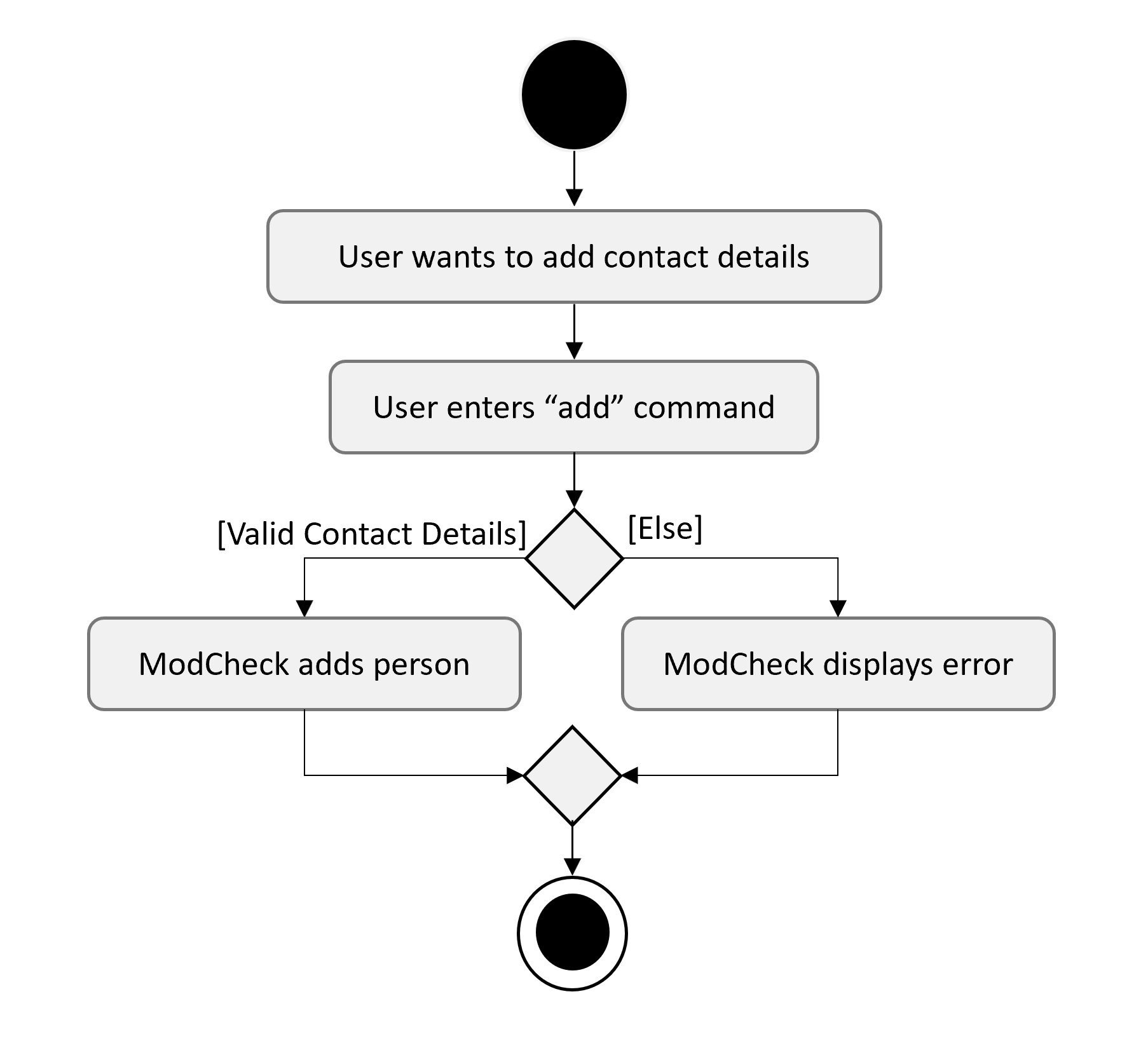
Undo/redo feature
Implementation
The undo/redo mechanism is facilitated by UndoManager and an Undoable interface. The UndoManager is
responsible for saving the version history of a ModelManager. The Undoable interface is implemented by a
Model to indicate that it has support for undo and redo functionality.
The Undoable interface requires the implementation of the following functions:
-
Undoable#hasUndoableCommand(): To allow the user of theUndoableobject to check if a command exists that can be undone -
Undoable#hasRedoableCommand(): To allow the user of theUndoableobject to check if a command exists that can be redone -
Undoable#executeUndo(): To allow the user of theUndoableobject to undo to a previous saved state -
Undoable#executeRedo(): To allow the user of theUndoableobject to redo to a later saved state
The ModelManager object implements the Undoable interface. It has an UndoManager object to manage the
implementation in the various required undo and redo functionality. The UndoManager object is responsible for
saving previous versions of AddressBook, keeping track of which version is currently shown to the user, and
yielding saved versions of AddressBook objects whenever requested.
Given below is an example usage scenario and how the undo/redo mechanism behaves at each step.
Step 1. The user launches the application for the first time. The UndoManager will be initialized with
addressBookHistory containing only the current addressBook state. The versionTracker variable is initialized to
0, indicating 0 undos have been executed so far, and the version of ModCheck shown is the most recent version.
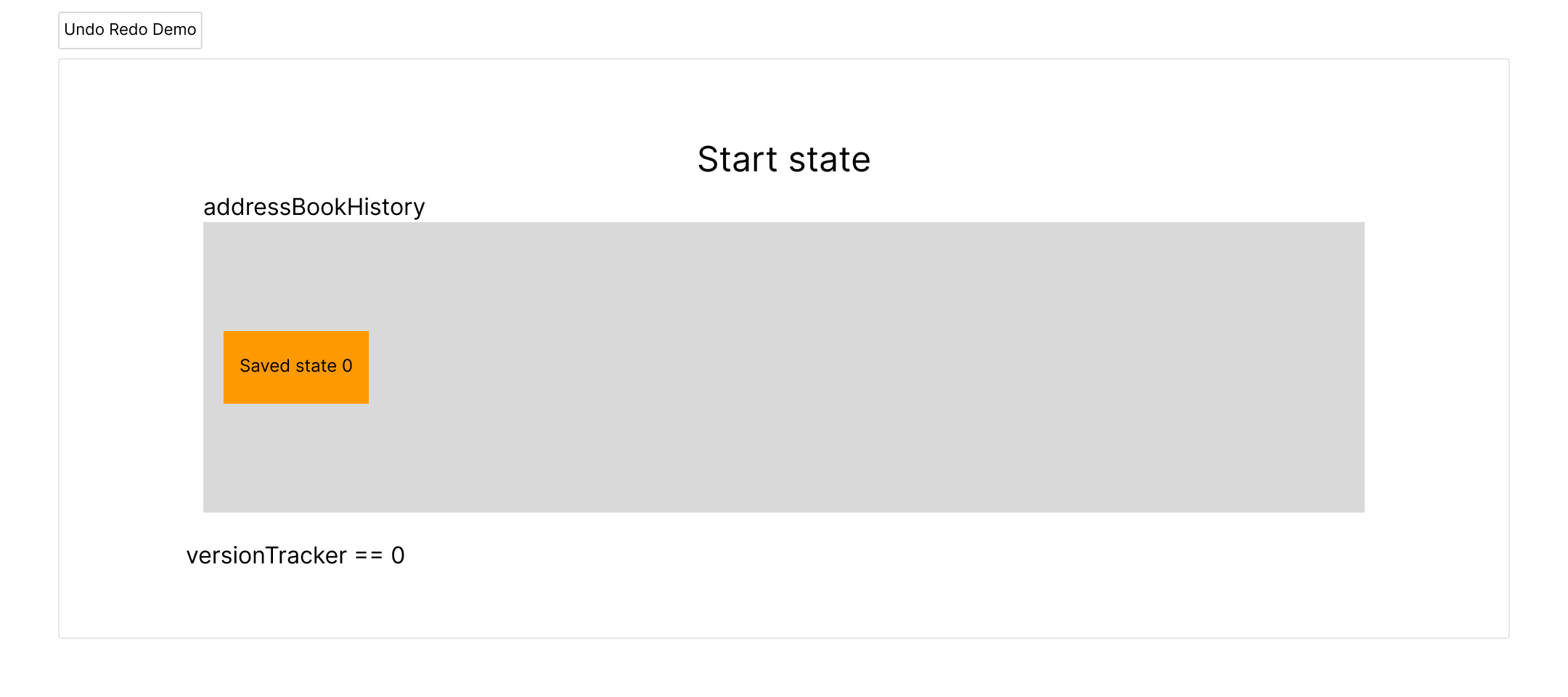
Step 2. The user executes delete 5 command to delete the 5th person in the address book.
The delete command calls UndoManager#addToHistory(), causing the modified state of the address book after the
delete 5 command executes to be saved in addressBookHistory. The versionTracker variable stays at 0 as the
addressBook state after deleting is still the most recent version.
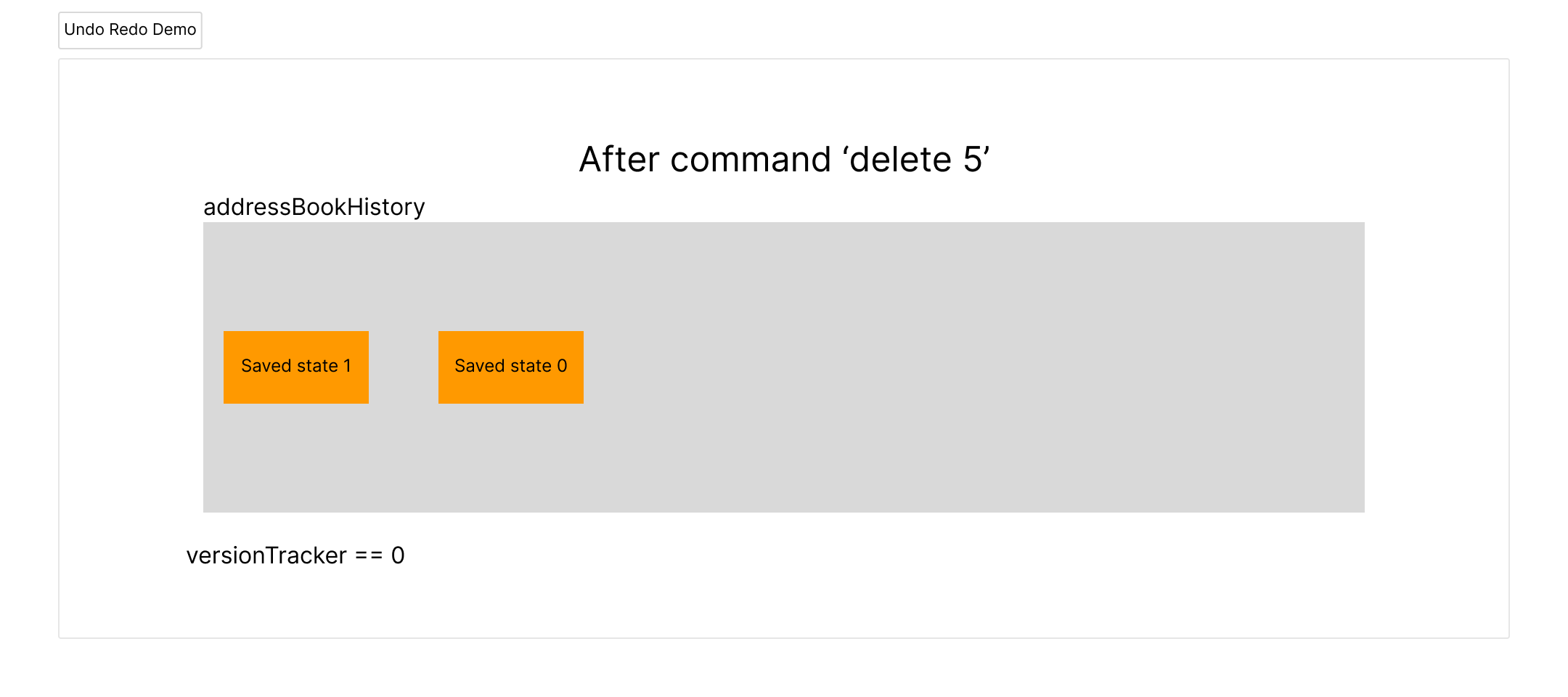
Step 3. The user executes add n/David … to add a new person.
The add command also calls UndoManager#addToHistory(), causing another modified address book state to be saved into
the addressBookHistory. Similarly, versionTracker remains at 0.
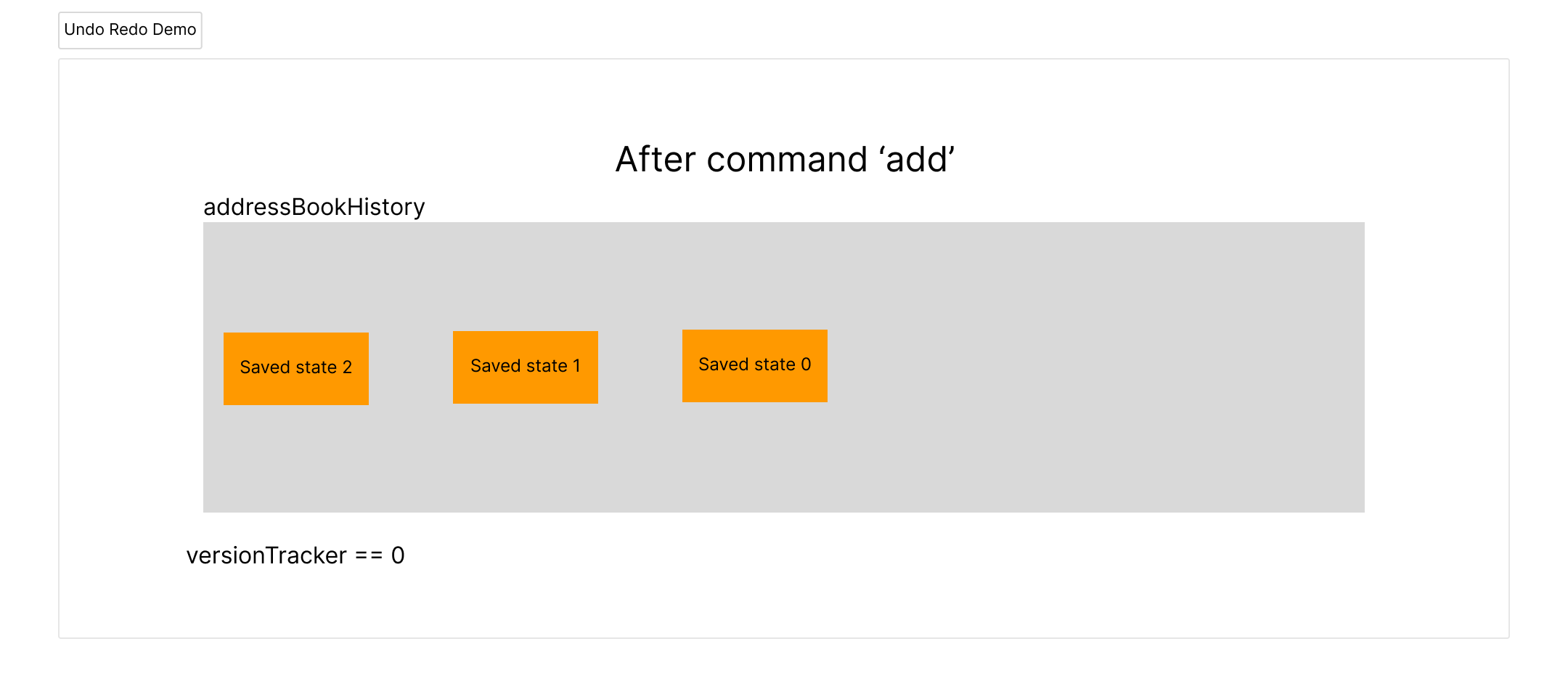
UndoManager#addToHistory(), so the address book state will not be saved into the addressBookHistory.
Step 4. The user now decides that adding the person was a mistake, and decides to undo that action by executing the
undo command. The undo command will call UndoManager#getPreviousHistory(). This method increases the
versionTracker variable by 1. Internally, the UndoManager will find the first most recent saved history, and
returns a copy of the addressBook representing that.
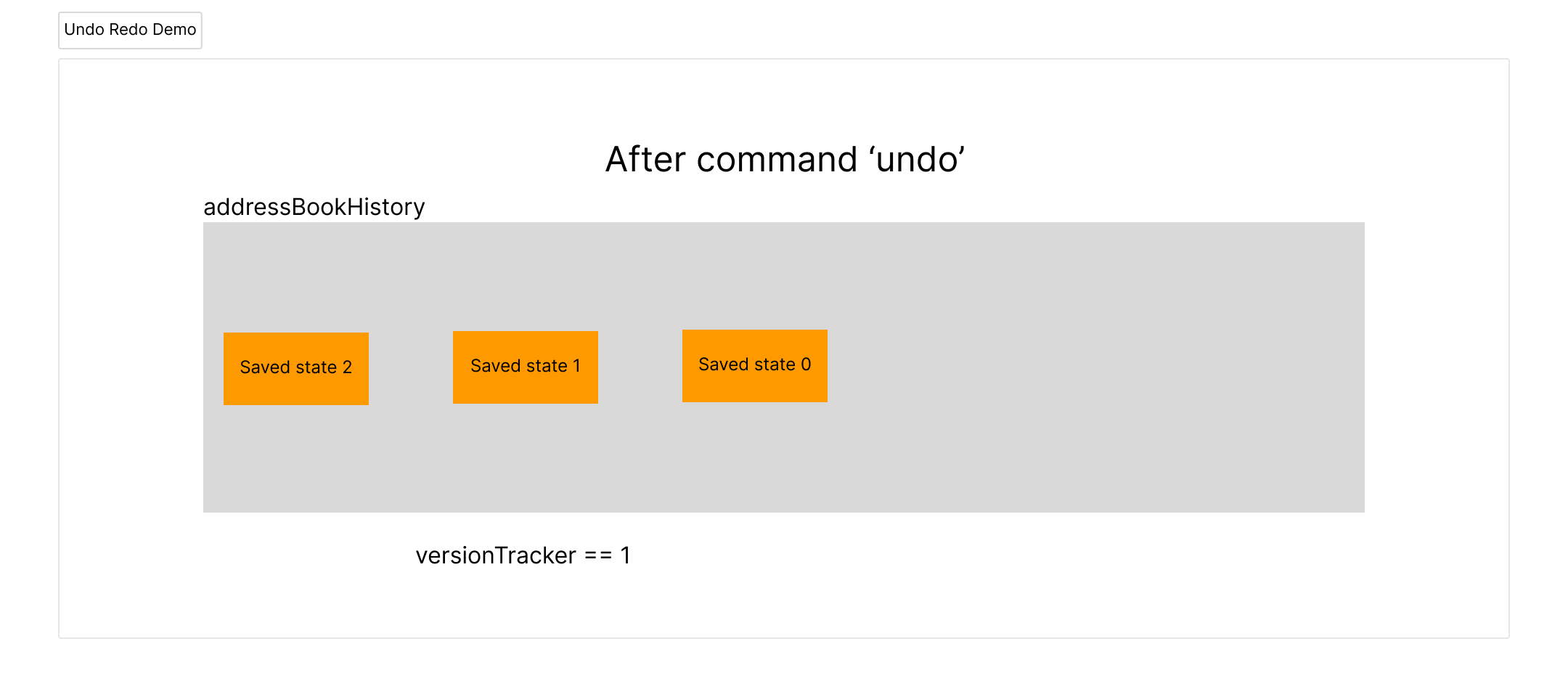
versionHistory is equal to the
number of number of saved histories, there is no more saved history to undo. The undo command uses
Model#hasUndoableCommand() to check if this is the case. If so, it will return an error to the user rather
than attempting to perform the undo.
The redo command does the opposite — it calls Undoable#getNextHistory(), which decreases the versionTracker by
1, and returns a copy of the addressBook representing the state of the addressBook after redoing.
versionTracker is 0, pointing
to the latest address book state, then there are no undone AddressBook states to restore. The
redo command uses Undoable#hasRedoableCommand() to check if this is the case. If so, it will return an error to the
user rather than attempting to perform the redo.
Step 5. The user then decides to execute the command list. Commands that do not modify the address book, such as
list, will not call UndoManager#addToHistory(). Thus, the addressBookHistory remains unchanged.
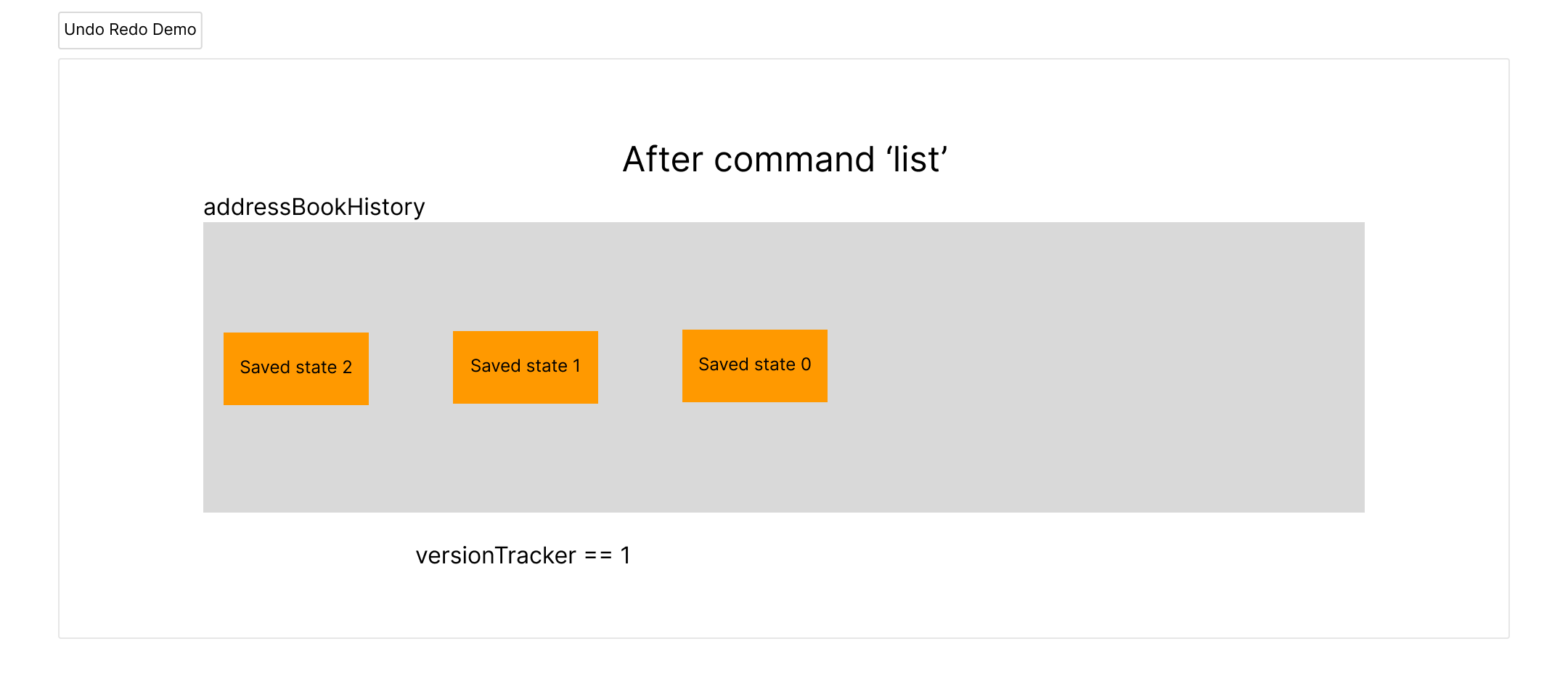
Step 6. The user executes clear, which calls UndoManager#addToHistory(). Since the versionTracker is not
0, all address book states from index 0 to one before the current version will be purged, and the versionTracker
will be reset to 0. Reason: It no longer makes sense to redo the “untracked heads”. This is the behavior that most
modern desktop applications follow.
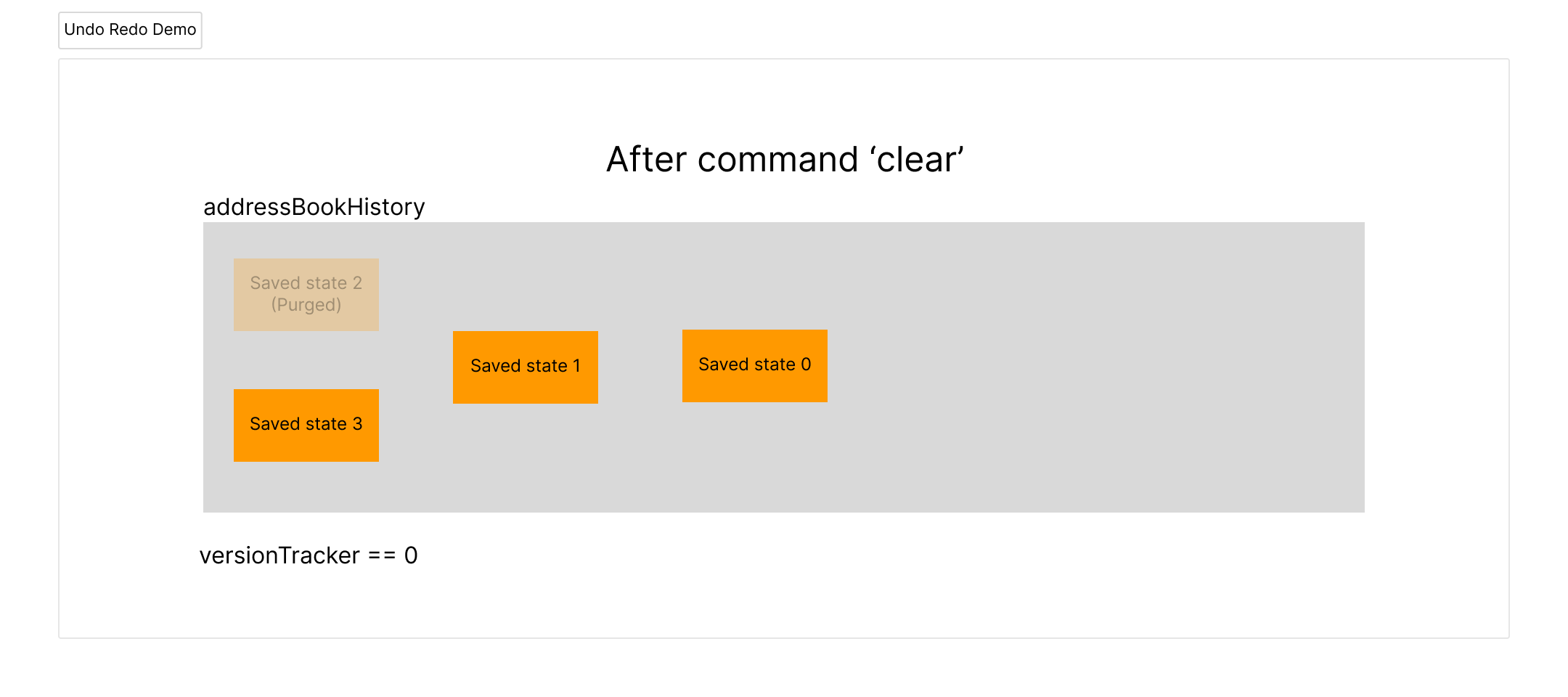
Below is the sequence diagram showing how a modification is added to the undoManager, using AddCommand as an
example.
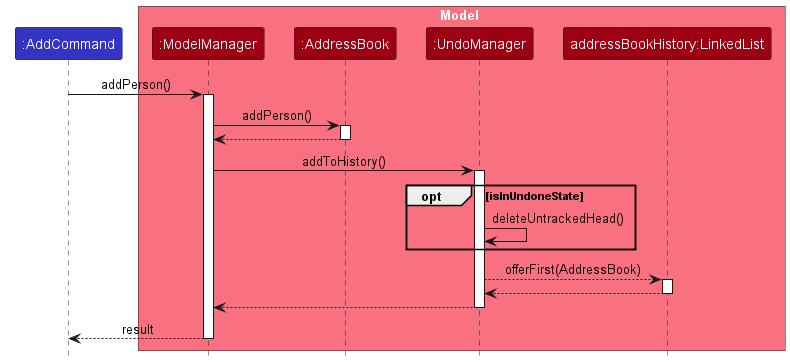
Below is the sequence diagram indicating what happens when the user executes undo.
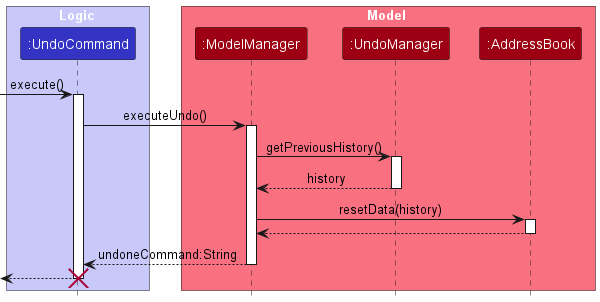
Login
Purpose: Allow user to login into ModCheck with password.
Implementation
Below is an activity diagram that shows what happens when a user logins into ModCheck.
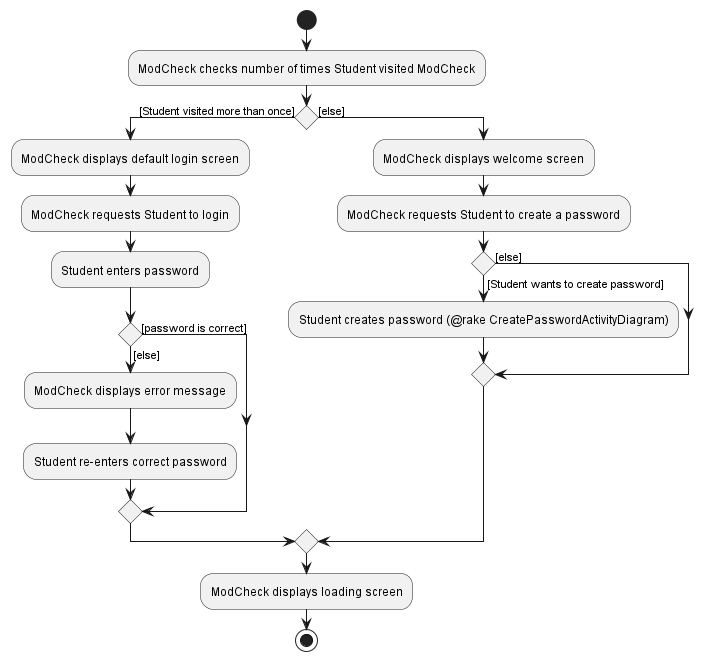
Create Password
Purpose: Allow user to create a password to secure ModCheck
Implementation
Below is an activity diagram that shows what happens when a user tries to create a new password
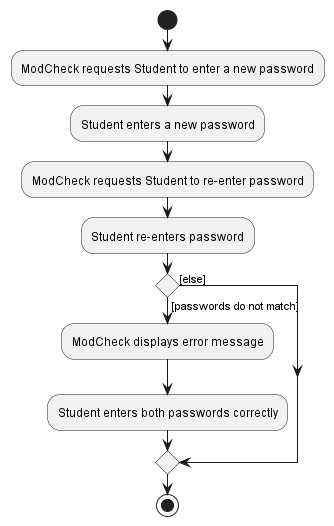
Delete contact
Purpose: Allow user to delete contacts that a user no longer needs.
Formats:
delete <index>delete <index>,<index>,...delete <name>
Implementation
The implementation of this feature requires DeleteCommand, DeleteCommandParser, DeleteSingleIndexCommand, DeleteMultipleIndexCommand and DeleteByNameCommand.
Below is an activity diagram that shows what happens when a user executes the delete command.
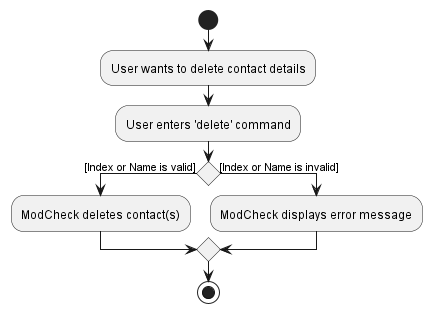
Edit contact details
Purpose: Allow user to edit contacts that are outdated.
Formats:
edit <index>edit <name>
Implementation
The implementation of this feature requires EditCommand, EditCommandParser, EditByIndexCommand, and EditByNameCommand.
Below is an activity diagram that shows what happens when a user executes the edit command.
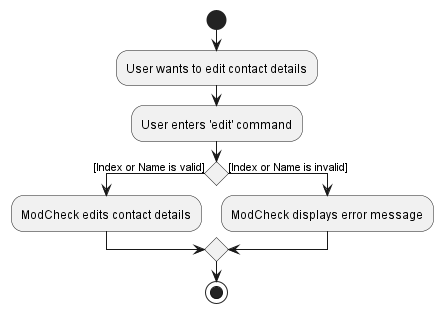
Filtering contacts
Purpose: Allow user to filter contacts based on criteria given.
Formats:
filter n/NAMEfilter p/PHONE_NUMBERfilter e/EMAIL_ADDRESSfilter d/DESCRIPTIONfilter t/TAG
Implementation
The implementation of this feature requires ‘FilterCommand’ and ‘FilterCommandParser’.
Below is an activity diagram that shows what happens when a user executes the filter command
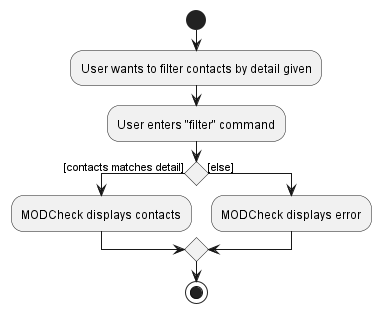
Viewing contacts
Purpose: Allow user to view contacts that are hidden by default based on index given
Formats:
view <index>view <index> <index> ...
Implementation
The implementation of this feature requires ViewCommand, ViewCommandParser and MatchNamePredicate.
Below is an activity diagram that shows what happens when a user executes the view command.
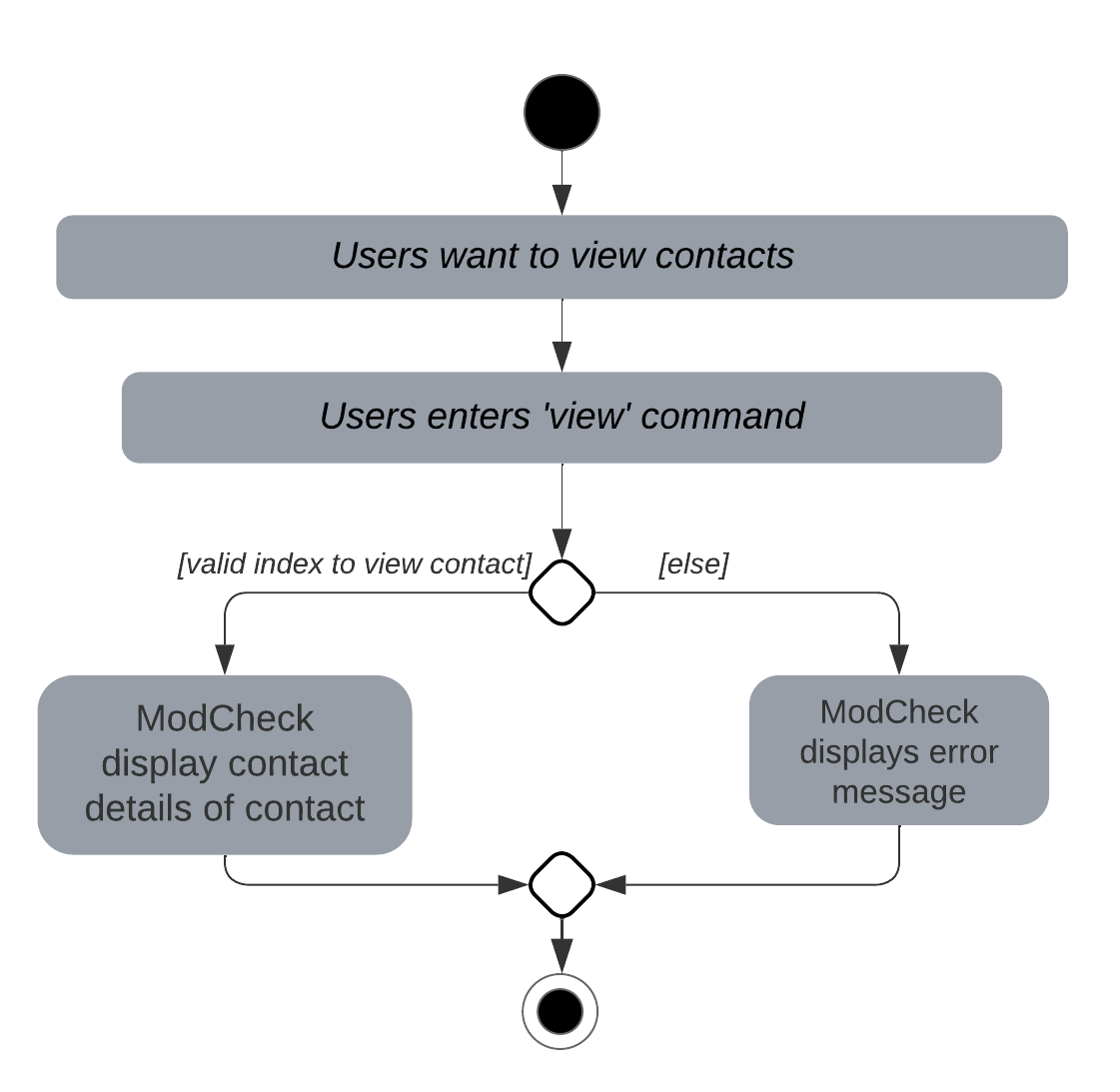
Export contacts
Purpose: Allow user to export contacts that are hidden by default based on index given
Formats:
export <index>export <index> <index> ...
Implementation
The implementation of this feature requires ExportCommand and ExportCommandParser.
Below is an activity diagram that shows what happens when a user executes the export command.
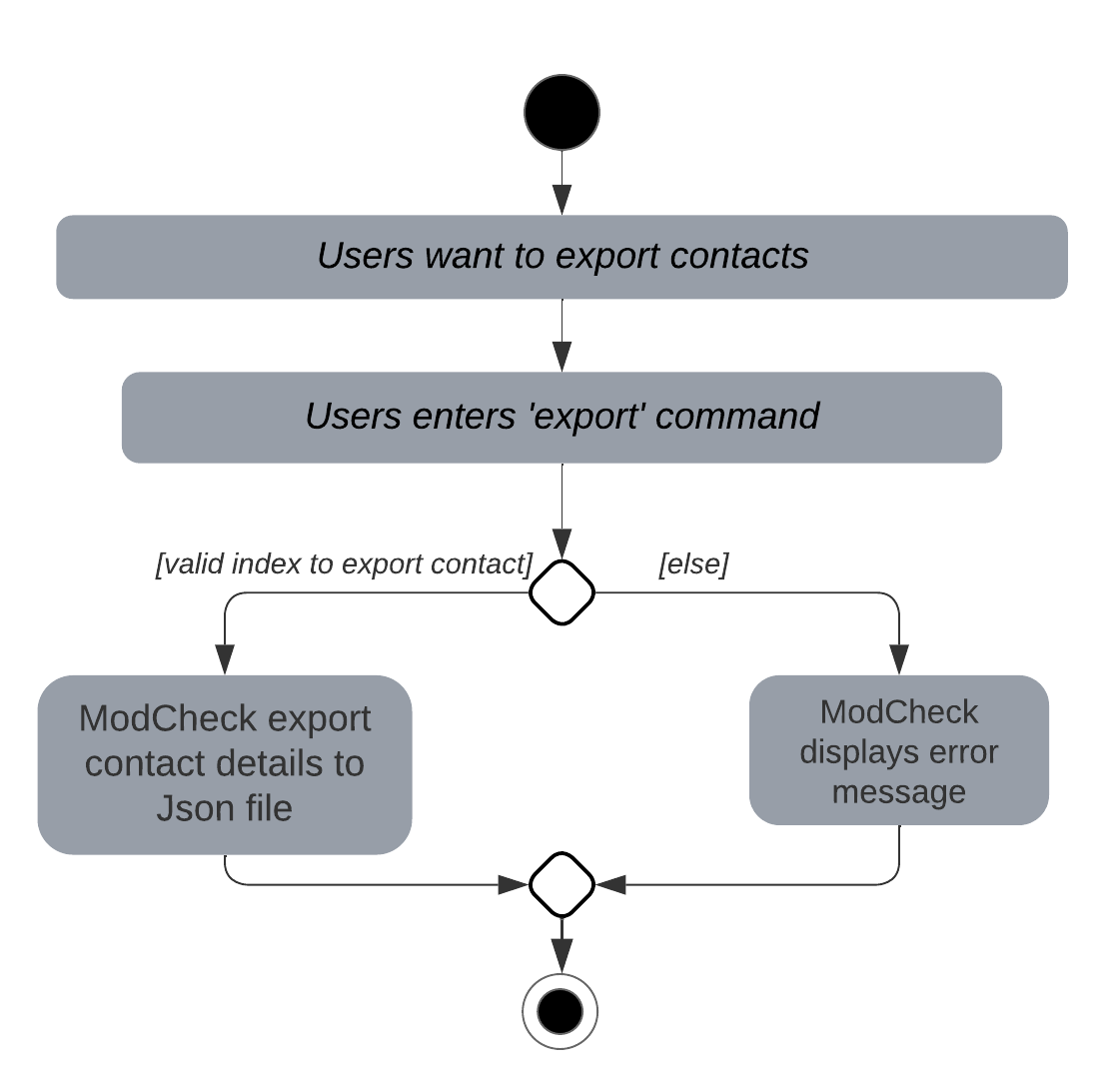
Load contacts
Purpose: Allows users to load data files generated by another ModCheck (either through export or copy-pasting
from data/addressbook.json).
Formats:
loadload <path>
Implementation: The behaviour of the load command is to open a FileChooser window of the current OS. Only
json files are able to be selected by this FileChooser window. After the user selects a file, the absolute path of
the file will be returned by the FileChooser. This path is appended onto the load command, which is subsequently
parsed by the AddressBookParser.
The parsed command will be executed by Logic. During execution, the LoadCommand object parses and reads the input
data file, and returns an AddressBook. This is then combined with the current working address book using the
Model#combine method.
This implementation requires cooperation between the Ui and Logic components of ModCheck, which is achieved using a UiInputRequiredException thrown by the parser. This exception is caught by Ui, which is then responsible for showing the FileChooser window. This is done so the architecture of ModCheck is not violated.
The possible paths of the load command is shown in the activity diagram below.
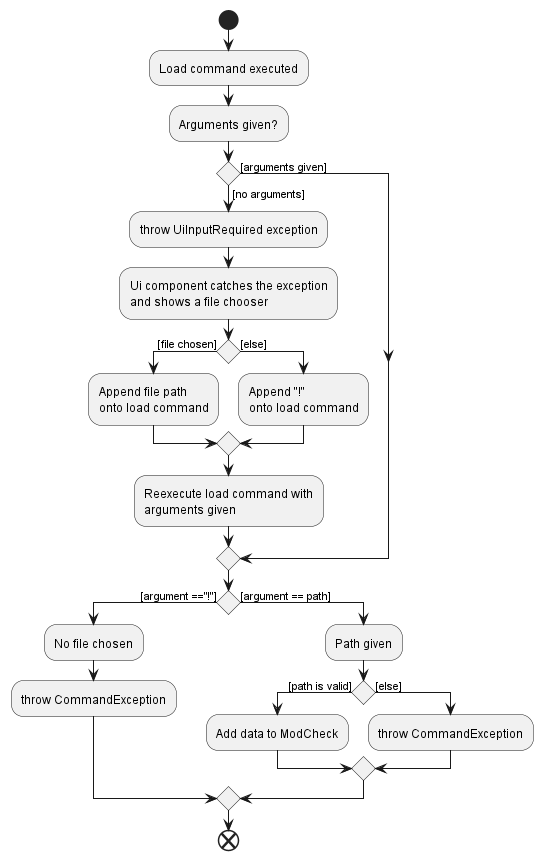
Dark/Light mode
Purpose: Allows users to change to their favourite theme
Formats:
lightdark
Implementation:
The implementation of this feature requires LightCommand and DarkCommand.
ModCheck will save the user’s favorite theme automatically. When the user exits the app, the handleExit() method in the MainWindow class will save the user last used theme to preferences.json so that when the user returns to the app. The favorite theme will still remain.
Below is an activity diagram that shows what happens when a user executes the light or dark command
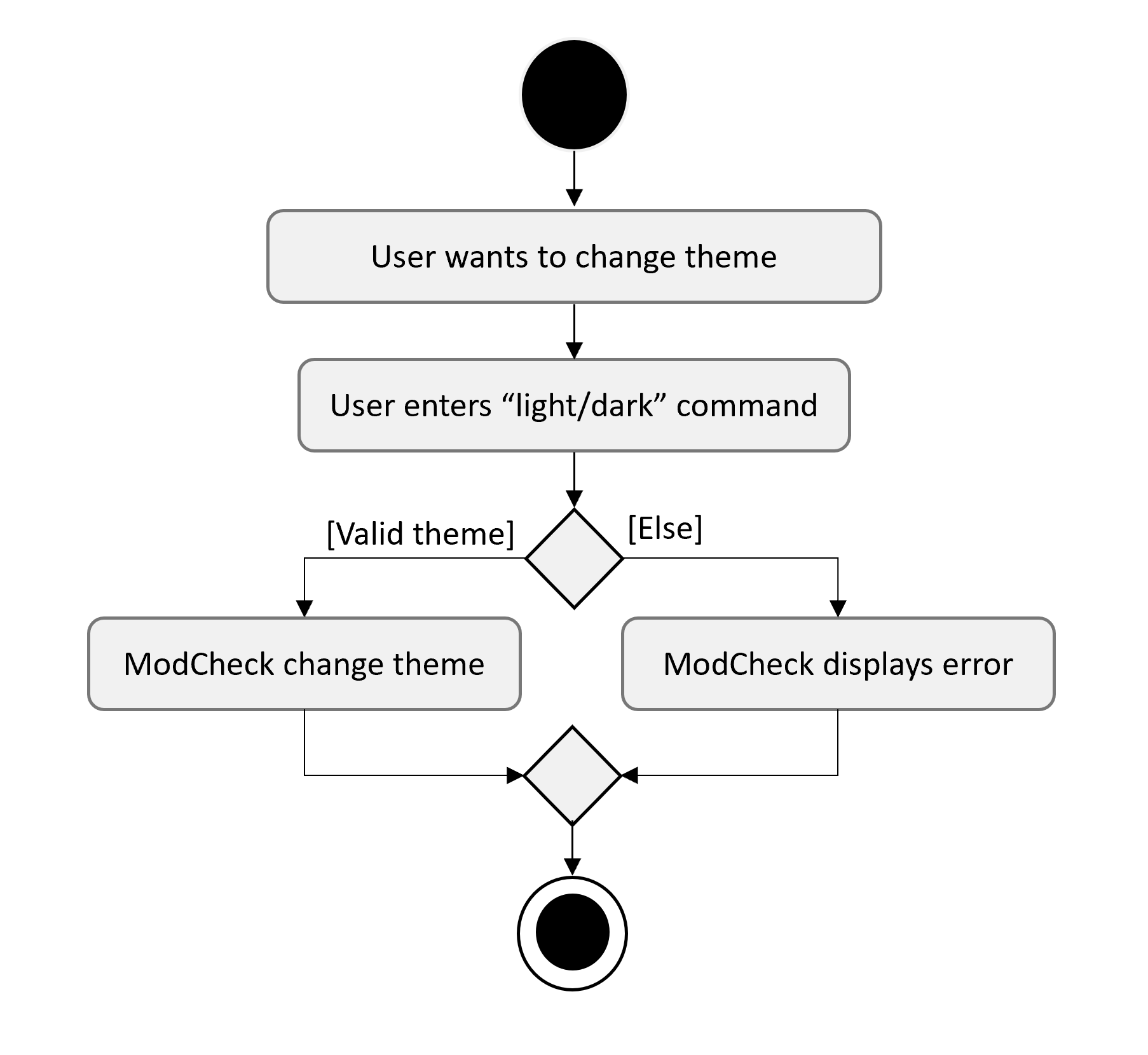
Documentation, logging, testing, configuration, dev-ops
Appendix: Requirements
Product scope
Target user profile:
- students from NUS
- has a need to manage a significant number of contacts
- prefer desktop apps over other types
- can type fast
- prefers typing to mouse interactions
- is reasonably comfortable using CLI apps
Value proposition: manage contacts faster than a typical mouse/GUI driven app
User stories
Priorities: High (must have) - * * *, Medium (nice to have) - * *, Low (unlikely to have) - *
| Priority | As a … | I want to … | So that I can… |
|---|---|---|---|
* * * |
Student | see usage instructions | refer to instructions when I forget how to use the App |
* * * |
Student | add a new contact | |
* * * |
Student | delete a contact | remove a contact that I no longer need |
* * * |
Student | view a person’s contact details | contact the person(TA/Professor) to seek help for my tutorials |
* * * |
Student | filter a contact by name | locate details of persons without having to go through the entire list |
* * * |
Student | filter my contacts by tag | find my contacts that is related to the tag quickly |
* * * |
Student | filter my contacts by module | find all the relevant contacts of a module I am taking |
* * * |
Student | filter my contacts by description | find all contacts with the matching description |
* * * |
Student | filter my contacts by phone number | find all contacts that has the phone number |
* * * |
Student | edit a contact | update the contact details of my contacts when they change |
* * * |
Student | assign modules to my contacts | know which of my contacts are in charge of which modules |
* * |
Student | login into ModCheck | access ModCheck privately |
* * |
Student | create a new password | secure ModCheck and prevent other unwanted users from using it |
* * |
Student | undo my last command | reverse my actions if i made a wrong change to ModCheck |
* * |
Student | be able to set certain fields as ‘unknown’ | add contacts that I may not know all the details of |
* * |
Student | hide private contact details | minimize chance of someone else seeing them by accident |
* * |
Student | delete all contacts | remove all contacts for a fresh start |
* |
Student | use the arrow keys to re-enter my previous commands | enter recently used commands much faster |
* |
Student | export selected contacts | transfer those contacts easily |
Use cases
(For all use cases below, the System is the ModCheck and the Actor is the Student, unless specified otherwise)
Use case: Login
MSS
- ModCheck displays default login screen
- ModCheck requests for Student’s password
- Student enters password
- ModCheck displays loading screen Use case ends.
Extensions
- 1a. ModCheck detects that student is a first time user.
- 1a1. ModCheck displays welcome screen.
- 1a2. ModCheck request for student desire to create password.
-
1a3. Student request to create password.
Use case ends.
- 3a. ModCheck detects that password given is wrong.
-
3a1. ModCheck displays error message.
Use case resumes at step 2.
-
Use case: Create password
MSS
- ModCheck request for Student’s new password.
- Student enters new password.
- ModCheck request for the same password for confirmation.
- Student enters password.
-
ModCheck displays success loading screen.
Use case ends.
Extensions
- 4a. ModCheck detects that the confirmation password is not similar to the first password.
-
4a1. ModCheck displays error message
Use case resumes at step 4.
-
Use case: Add a person
MSS
- Student requests to add person.
- Student enters the contact details and submits.
-
ModCheck creates a new person.
Use case ends.
Extensions
- 2a. Person already exists in ModCheck.
- 2a1. ModCheck shows an error message. Use case continues at step 2.
- 2b. Contact details is missing the field NAME.
- 2b1. ModCheck shows an error message. Use case continues at step 2.
- 2c. Contact details given is incorrect
- 2c1. ModCheck shows an error message. Use case continues at step 2.
Use case: Delete a single person by Index
MSS
- Student requests to list persons
- ModCheck shows a list of persons
- Student requests to delete a specific person in the list
-
ModCheck deletes the person
Use case ends.
Extensions
-
2a. The list is empty.
Use case ends.
-
3a. The given index is invalid.
-
3a1. ModCheck shows an error message.
Use case resumes at step 2.
-
Use case: Delete multiple persons by multiple indexes
MSS
- Student requests to list persons
- ModCheck shows a list of persons
- Student requests to delete multiple persons in the list
-
ModCheck deletes the persons
Use case ends.
Extensions
-
2a. The list is empty.
Use case ends.
-
3a. One of the given indexes is invalid.
-
3a1. ModCheck shows an error message.
Use case resumes at step 2.
-
Use case: Delete single person by name
MSS
- Student requests to list persons
- ModCheck shows a list of persons
- Student requests to delete person in the list by their name.
-
ModCheck deletes the person
Use case ends.
Extensions
-
2a. The list is empty.
Use case ends.
-
3a. There is no person with the specified name.
-
3a1. ModCheck shows an error message.
Use case resumes at step 2.
-
-
3b. There are multiple persons with the same name.
-
3b1. ModCheck shows an error message with a list of persons with the same name.
Use case ends.
-
Use case: Filter contacts
MSS
- Student requests to filter contacts with the required details
-
ModCheck shows a list of persons based on details given
Use case ends.
Extensions
-
2a. There are no contacts that matches the details given
-
2a1. ModCheck shows an error message.
Use case ends.
-
Use case: Export contacts
MSS
- Student requests to export selected contact
- ModCheck shows a list of persons selected
-
ModChecks exports selected contacts
Use case ends.
Extensions
- 1a. Student requests to export multiple contacts
- Use case resumes at step 2.
- 1b. Student provide invalid request to export contacts
- 1b1. ModCheck shows an error message.
- Use case ends.
Use case: Load contacts
MSS
- Student requests ModCheck to load contacts.
- ModCheck shows a FileChooser and requests student to choose a file to load from.
- Student selects a file to load.
-
ModCheck loads the contacts in the file into its database.
Use case ends.
Extensions
- 3a. Student requests to load an invalid file.
- 3a1. ModCheck shows an error message.
Use case ends.
- 3b. Student does not choose a file to load.
- 3b1. ModCheck shows an error message.
Use case ends.
Use case: View a person’s contact details
MSS
- Student requests to list contacts.
- ModCheck shows a list of contacts.
- Student requests to view a specific contact in the list.
-
ModCheck displays the person’s contact details.
Use case ends.
Extensions
-
2a. The list is empty.
Use case ends.
-
3a. The given index is invalid.
-
3a1. ModCheck shows an error message.
Use case ends.
-
-
3b. User requests to view multiple people in the list.
- 3b1. ModCheck validates indexes given is correct.
-
3b2. ModCheck displays all person’s contact details.
Use case ends.
- 3b1a. ModCheck validates indexes given is incorrect.
-
3b1b. ModChecks shows an error message.
Use case ends.
Use case: Edit a contact by index
MSS
- Student requests to list contacts.
- ModCheck shows a list of contacts.
- Student requests to edit a contact supplying new values for certain fields
-
ModCheck finds the relevant contact by index and edits it
Use case ends.
Extensions
-
2a. The list is empty.
Use case ends.
- 3a The new value for the specified field is invalid
-
3a1. ModCheck informs student that the given value for the specified field is invalid
Use case resumes at step 2.
-
-
4a. The given index is invalid.
-
4a1. ModCheck shows an error message.
Use case resumes at step 2.
-
Use case: Edit a contact by name
MSS
- Student requests to list contacts.
- ModCheck shows a list of contacts.
- Student requests to edit a contact supplying new values for certain fields
-
ModCheck finds the relevant contact by name and edits it
Use case ends.
Extensions
-
2a. The list is empty.
Use case ends.
- 3a The new value for the specified field is invalid
-
3a1. ModCheck informs student that the given value for the specified field is invalid
Use case resumes at step 2.
-
- 4a. The contact does not exist
-
4a1. ModCheck informs student that contact does not exist
Use case resumes at step 2
-
- 4b. There are multiple contacts with the same specified name.
-
4b1. ModCheck informs student that there are multiple contacts with the same specified name, and returns a list of contacts with the same specified name.
Use case ends.
-
Use case: Switch to light or dark mode
MSS
- Student requests to change to light or dark mode
-
ModCheck displays the selected outcome
Use case ends.
Extensions
- 1a. Already in the selected theme.
-
1a1. ModCheck shows an error message.
Use case ends.
-
Use case: Undo commands
MSS
- Student makes a request to undo a command.
-
ModCheck undoes the most recent command.
Use case ends.
Extensions
- 1a. There is no command to be undone.
- 3a1. ModCheck shows an error message.
Use case ends.
Non-Functional Requirements
- Should work on any mainstream OS as long as it has Java
11or above installed. - Should be able to hold up to 1000 persons without a noticeable sluggishness in performance for typical usage.
- A student with above average typing speed for regular English text (i.e. not code, not system admin commands) should be able to accomplish most of the tasks faster using commands than using the mouse.
- A student should be able to learn and use commands provided by MODCheck easily within an hour of usage.
- Should be able to handle exceptions, errors and invalid inputs without crashing.
- Should be able to still work even if there is no data file present.
- Should be able to function offline - data file and features should work without network connection
- Data file should be human-readable and editable with a simple text editor
{More to be added}
Glossary
- Mainstream OS: Windows, Linux, Unix, OS-X
- Contact: An entry in ModCheck describing a person, consisting of a name and fields containing contact details of that person
- Contact details: Information regarding a person’s phone number, email, office location, telegram, LinkedIn, or any other information relevant for students to communicate with that person
- Private contact detail: A contact detail that is not meant to be shared with others
- TA: Teaching Assistant - people who assists Professors in conducting tutorial, labs and other classes
- GUI: Graphical User Interface - a system of interactive visual components for computer software
- CLI: Command Line Interface - a text-based user interface (UI) used to run programs, manage computer files and interact with the computer
- Index: A number indicating the order or position in a given list
-
Person: Referring to TA or Professor
Appendix: Instructions for manual testing
Given below are instructions to test the app manually.
Launch and shutdown
-
Initial launch
-
Download the jar file and copy into an empty folder
-
Double-click the jar file Expected: Shows the GUI with a set of sample contacts. The window size may not be optimum.
-
-
Saving window preferences
-
Resize the window to an optimum size. Move the window to a different location. Close the window.
-
Re-launch the app by double-clicking the jar file.
Expected: The most recent window size and location is retained.
-
-
{ more test cases … }
Deleting a person
-
Deleting a person while all persons are being shown
-
Prerequisites: List all persons using the
listcommand. Multiple persons in the list. -
Test case:
delete 1
Expected: First contact is deleted from the list. Details of the deleted contact shown in the status message. Timestamp in the status bar is updated. -
Test case:
delete 1,2,3
Expected: First, second and third contacts are deleted from the list if there are at least three contacts in the list. Success shown in status message. -
Test case:
delete Amy
Expected: Amy is deleted from the list if there is only one contact named Amy. Details of the deleted contact shown in the status message. Timestamp in the status bar is updated. -
Test case:
delete 0
Expected: No person is deleted. Error details shown in the status message. Status bar remains the same. -
Other incorrect delete commands to try:
delete,delete x,...(where x is larger than the list size)
Expected: Similar to previous.
-
Viewing a person’s contact details
-
Viewing a person while all persons are being shown
-
Prerequisites: List all persons using the
viewcommand. Multiple persons in the list. Contact details not hidden-
Test case:
view 1
Expected: The contact details of the first person in the list is displayed in ModCheck. -
Test case:
view 1 3 4
Expected: The contact details of the first, third and fourth person in the list is displayed in ModCheck. -
Test case:
view 0
Expected: No person’s contact details is displayed. Error details shown in the status message. Status bar remains the same. -
Other incorrect delete commands to try:
view,view x,...(where x is larger than the list size)
Expected: Similar to previous.
-
-
Appendix: Planned Enhancements
-
Login featurewill include two other important details that ModCheck will have to capture which is the Student’susernameand a ` question dropdownsuch asWhat is you best friend name,What is your pet name,What is your favourite foodetc. so thatReset Password` feature can be realistically done to allow Students to reset their password safely. -
Reset password featureto be included in the future to allow Students to reset their password in case they forgot their password. - Hashing of password will be done in the future as current requirements require the data to be readable by human.
-
Loadcommand will include an option to override instead of ignore, this is to allow the user to update contacts if they know that the data file to be loaded is more recent.
Appendix: Known Limitations
-
Login featuredoes not provide a way for Student to reset password as it is very hard to identify if the user that wants to reset the password is actually the correct user using ModCheck. - The Student is expected to reset the password by going through
userData.jsonfile and modifying thehashedPasswordvariable directly. - Hashing was not implemented as the Student is only able to reset the password by modifying
userData.jsonwhich requires the data to be humanly readable.